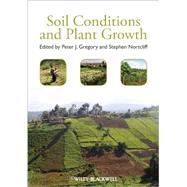
What is included with this book?
Peter J. Gregory is Chief Executive of East Malling Research and a Professor at the Centre for Food Security, School of Agriculture, Policy & Development, University of Reading. He is also the author of the Wiley-Blackwell-published book, Plant Roots, and co-author of the second edition of Science and the Garden.
Stephen Nortcliff is Emeritus Professor at the Soil Research Centre, Department of Geography and Environmental Science, University of Reading.
Contributors
Preface
1 The historical development of studies on soil–plant interactions
Stephen Nortcliff and Peter J. Gregory
1.1 Introduction
1.2 The search for the ‘principle’ of vegetation, –1750
1.3 The search for plant nutrients
1.4 The beginnings of soil microbiology
1.5 The development and application of modern knowledge of soils
References
2 Plant and crop science
Sayed Azam-Ali
2.1 Introductory principles of resource capture by crops
2.2 Growth and development
2.3 Solar radiation
2.4 Water
2.5 Integrating principles of resource capture by crops
2.6 Conclusion
References
3 Soil fertility
Elizabeth A. Stockdale, Keith W.T. Goulding, Timothy S. George, and Daniel V. Murphy
3.1 Introduction
3.2 Concepts of soil fertility
3.3 Plant–soil interactions determining soil fertility
3.4 Assessing soil fertility
3.5 Managing soil fertility
References
4 Soil organic matter
David Powlson, Pete Smith, and Maria De Nobili
4.1 Introduction
4.2 Factors influencing SOM content
4.3 Modelling SOM dynamics
4.4 Chemical structure of SOM as elucidated using new forms of spectroscopy – advances and pitfalls
4.5 Organo-mineral interactions
4.6 Fractionation methods for studying SOM
4.7 The living part of SOM – the soil microbial biomass
4.8 SOM and soil physical conditions and implications for plant growth
4.9 Soil C and climate change
References
5 Nitrogen and phosphorus cycles and their management
Phil M. Haygarth, Richard D. Bardgett, and Leo M. Condron
5.1 Introduction
5.2 Sources of nitrogen and phosphorus to soil-plant systems
5.3 Chemical and biological processes of nutrient cycling, transformations and bioavailability
5.4 Processes of nitrogen and phosphorus losses from soils
5.5 Nitrogen and phosphorus use in agricultural systems
5.6 Future soil nutrient cycles and environmental change
References
6 Properties and management of cationic elements for crop growth
Philip J. White and Duncan J. Greenwood
6.1 The movement of essential cationic elements to the root surface
6.2 Cationic elements in plants
6.3 The uptake of essential cationic elements from the rhizosphere
6.4 Cationic elements in the soil solution
6.5 Management practices increasing the acquisition of essential mineral cations
6.6 Genetic strategies to improve the efficiency of acquisition and physiological use of essential cationic elements
6.7 Concluding remarks
References
7 Managing adverse soil chemical environments
Mark E. Hodson and Erica Donner
7.1 Potentially toxic metals (PTMs)
7.2 Salt-affected soils (saline, sodic and saline-sodic soils)
7.3 Acid and alkaline soils
References
8 Managing the soil physical environment for plants
Paul D. Hallett and A. Glyn Bengough
8.1 Introduction
8.2 Basic physical properties of soil
8.3 Soil structure
8.4 Soil tilth and seedbeds
8.5 Critical soil physical conditions for plant growth
References
9 Soil water and its management
Anne Verhoef and Gregorio Egea
9.1 Soil water management – a general overview
9.2 Key concepts related to water in soil
9.3 Soil water and plants
9.4 Determination of soil water balance and related variables
9.5 Water management to alleviate soil water shortage
9.6 Water management to alleviate excess water
References
10 Plant-induced changes in soil processes and properties
Philippe Hinsinger
10.1 Introduction
10.2 Roles of plants in carbon cycling: deposition, burial and emission
10.3 Roles of plants in soil acidification
10.4 Roles of plants in the weathering of soil minerals
10.5 Conclusion
References
11 Sustainable management of soil and plant health by optimising soil biological function
Dominic Standing and Ken Killham
11.1 Introduction
11.2 Managing soil and plant health
11.3 Conclusion
References
12 Managing the soil–plant system for the delivery of ecosystem services
David W. Hopkins and Edward G. Gregorich
12.1 Introduction
12.2 Roles of soils
12.3 Sustainable soil use and soil quality
12.4 Concluding remarks
References
13 The new challenge – sustainable production in a changing environment
Peter J. Gregory and Stephen Nortcliff
13.1 Introduction
13.2 Human-induced environmental change
13.3 Food security and food production
13.4 Routes to sustainable intensification
References
Index
Colour plate section
The New copy of this book will include any supplemental materials advertised. Please check the title of the book to determine if it should include any access cards, study guides, lab manuals, CDs, etc.
The Used, Rental and eBook copies of this book are not guaranteed to include any supplemental materials. Typically, only the book itself is included. This is true even if the title states it includes any access cards, study guides, lab manuals, CDs, etc.